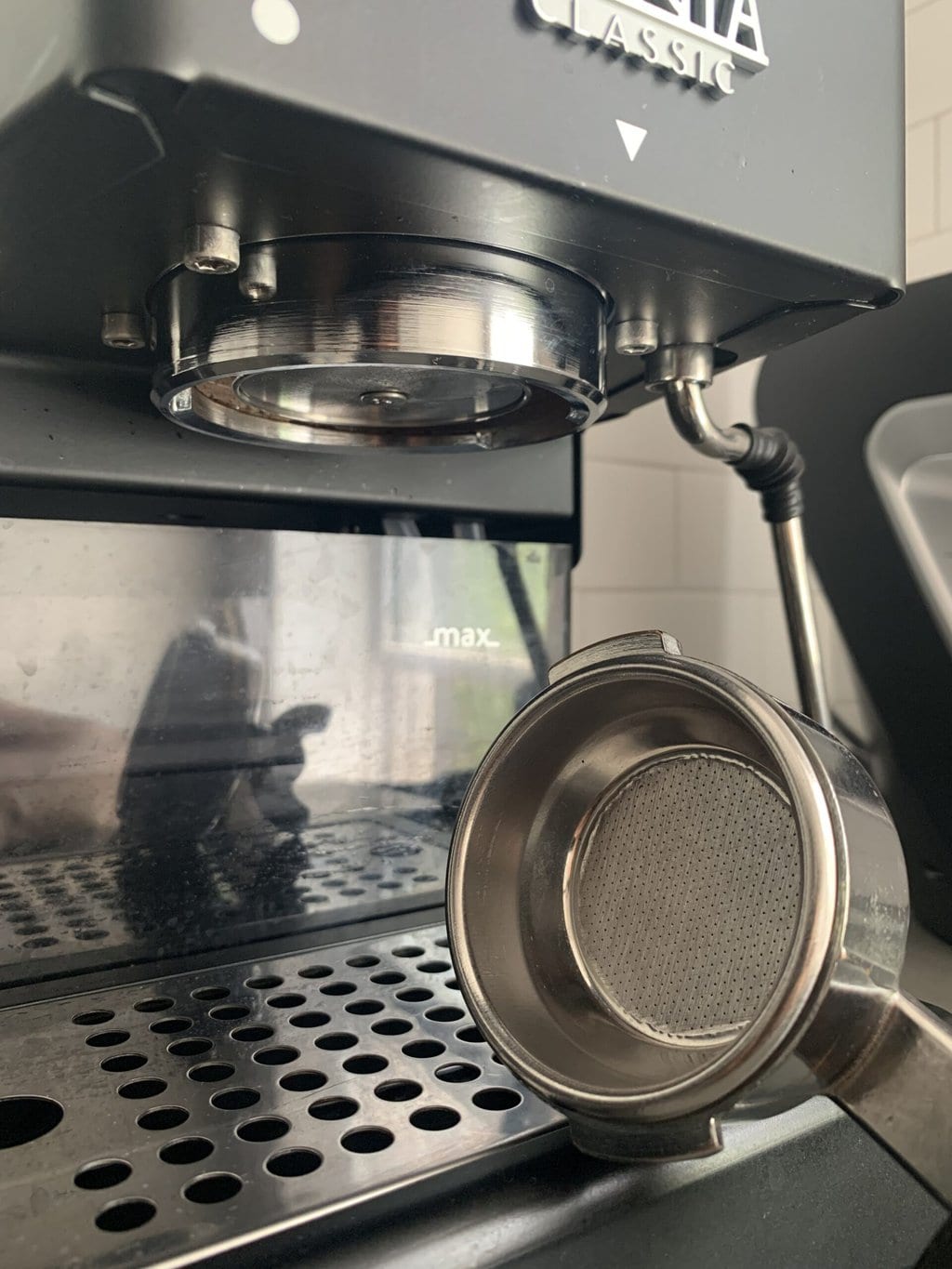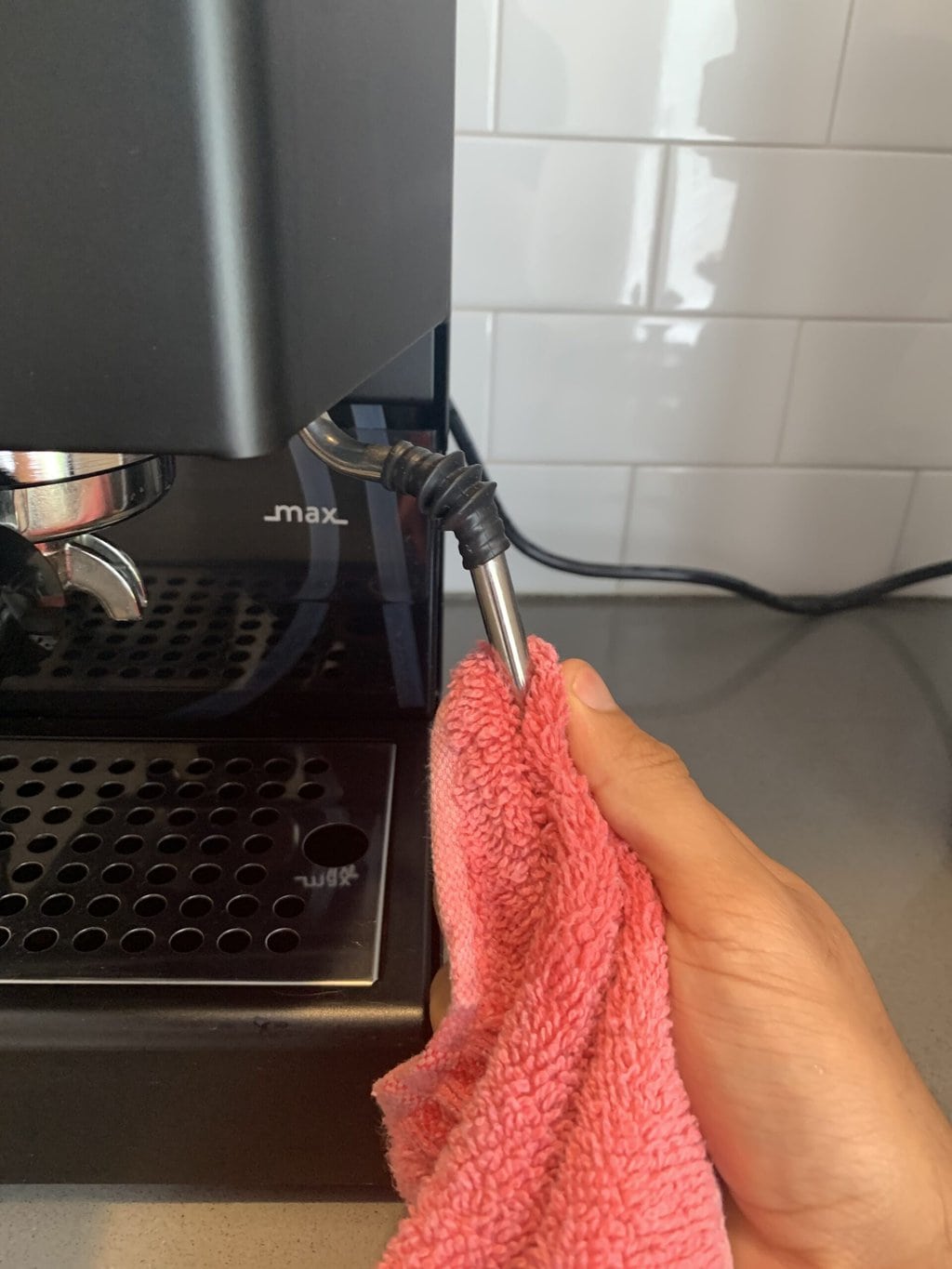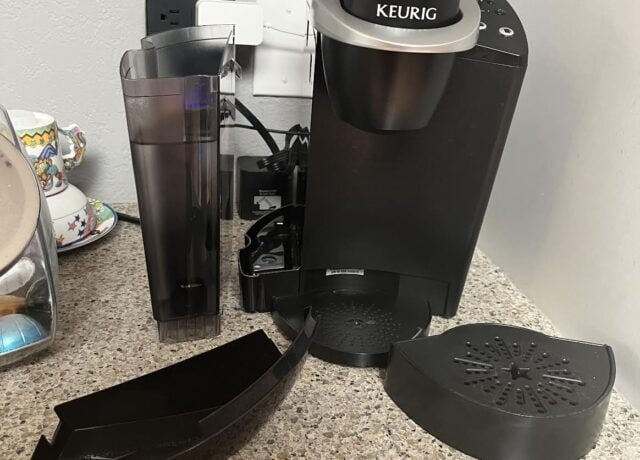You’ve made the investment and finally gotten yourself a home espresso machine, and you’re enjoying espresso every morning. But over time, you start to notice your espresso is tasting burnt and bitter, and you’re not getting that nice layer of crema you got when the machine was new.
Your machine needs some cleaning! Espresso machines are complex appliances that require a little more attention than your average coffee maker. The buildup of leftover grounds, milk residue, and minerals from your water can be very harmful to your machine. Performing a few basic cleaning and maintenance tasks will dramatically extend your espresso machine’s life and keep your espresso tasting its best.

I’ll walk through the cleaning process for my Gaggia Classic Pro. However, these tasks are universal to nearly any semi-automatic espresso machine.
Cleaning and Maintenance for Gaggia Espresso Machines: Every Day Cleaning
First, we’ll start with some basic tasks that you’ll want to do every time you finish your brewing process. Leaving your machine clean every day will reduce the effects of long-term buildup.

Cleaning Your Group Head
You’ll want to purge your group head after you pull a shot of espresso. Remove your portafilter and hit the espresso button to flush water through the dispersion screen for a few seconds. Wipe your group head clean with a wet cloth to remove anything left over. This will clear espresso grounds and coffee oils from your group head.

While you have your portafilter and basket out, wipe away any remaining grounds and oils. Make sure your dry any residual water before locking it back into the group head. Performing this task daily will prevent excess coffee buildup in your machine.
Cleaning the Water Tank
Poor water quality or excess water hardness can cause scale buildup in your espresso machine. Unfiltered water is filled with minerals that build up in your machine over time and shorten the life of parts.
Make sure that you are using only filtered water in your water tank. Investing in a water softening filter system will reduce limescale buildup. Remove your water tank and rinse it daily with fresh water to keep it clean.
Cleaning the Steam Wand
Milk residue can easily build up on your Gaggia Pannarello Wand, so daily steam wand purging and cleaning are important. Immediately after using your steam wand, remove it from the milk, run more steam through it, and wipe it with a wet cloth. This will prevent your steam wand from clogging.

Every 2 Months
After several weeks of daily use, you’ll need to do a deeper cleaning of your espresso machine to clear the buildup of espresso oils, coffee grounds, and limescale. Perform these tasks at least every 2-3 months, or monthly if you use your machine more frequently.
Descaling or Decalcifying
The decalcifying process will clear your machine of limescale buildup that can wreak havoc on espresso machine internals and affect the flow of water. For this process, you’ll need a decalcifying solution. For your Gaggia Classic, the manufacturer recommends their Gaggia brand solution. I wouldn’t recommend using a homemade descaling solution such as vinegar or lemon juice because this can leave a lasting flavor in your machine.

To descale with the Gaggia solution, pour half of a 250-milliliter bottle into your water tank and fill the rest with water. Turn on your machine and dispense two cups of water through the steam wand into a container by pressing the espresso and steam button at the same time. Turn off your coffee maker and wait 20 minutes to allow the solution to take effect.
After you wait, dispense two cups of water again through the steam wand. Wait three minutes and repeat this process. Do this until the water reservoir is completely empty.
Finally, you’ll need to rinse water through your machine. Dispense a full tank of water through the steam wand and another full tank through the portafilter. Repeat this process one more time for a total of four tanks. Your machine is now descaled and ready for use!
Backflushing
Backflushing clears coffee oils from your dispersion screen and group head assembly. Although your group head might look clean from the outside, coffee oils are building up behind your shower screen plate.
To backflush, you’ll need a detergent such as Cafiza and a backflushing disk. Insert the backflushing disk into your portafilter basket and fill it with a teaspoon of detergent. Hit the brew button for a few seconds and then turn it off. You’ll notice detergent and oils flowing from your drain pipe. After repeating this step 4 more times, remove your portafilter and rinse it with water. Flush water through your group head to rinse it out.
Reinsert your portafilter and repeat this process without adding any more detergent. Give your portafilter and group head another rinse, and you’re all done.
Every 6 Months
Steam Wand Deep Cleaning
Your steam wand will accumulate some milk buildup that your daily wand cleaning won’t clear. Choose a specialized steam wand cleaning solution such as Rinza. Soaking your steam wand in Rinza for 15 – 20 minutes will keep your steam wand clean.
Annual Maintenance
Replacing the Group Gasket and Screen
If you have a worn or broken gasket, you will need to replace it to get your machine up and running. It’s not necessary to replace your worn group gasket and screen unless your group head is leaking. Typically this won’t happen until at least a year of use.
You’ll need a number 2 Phillips head screwdriver, a 5-millimeter Allen key, a flathead screwdriver, needle-nose pliers, and a screw to perform this maintenance. Remove the water reservoir, portafilter, drainpipe, drip tray, and water reservoir cover. Lay the machine on its back.
Remove the shower screen screw with the Phillips head screwdriver, and remove the shower screen plate with the Allen key. If the plate doesn’t fall out on its own, use your flathead screwdriver to remove it. Clear out any buildup with a descaler and a stiff brush.
Your group gasket is now exposed. If you cannot remove the large gasket by hand, pry it out using a screw and pliers. Drive a screw into your gasket using a screwdriver, and pull it out with the pliers. Once the gasket is out, clear any debris before installing a new rubber gasket. Reattach your shower screen and shower screen plate. Your machine is now back in service!
Summary
Following these essential maintenance procedures will keep your machine free of coffee oils, limescale, and milk residue. Depending on how often you use your brewer, you may perform these tasks more frequently. As long as you perform regular maintenance, your machine will deliver tasty espresso for years to come!
Happy Caffeinating!







